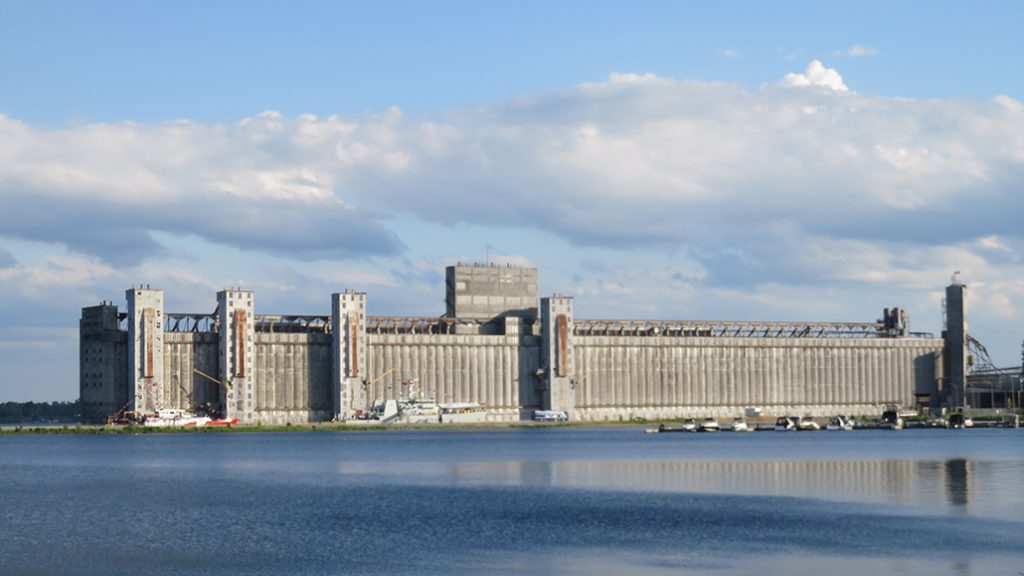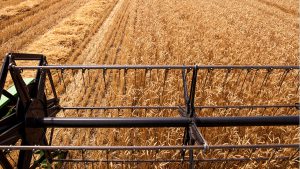The Port of Johnstown
A CRUCIAL LINK FOR EASTERN ONTARIO FARMERS

AS THE HARVEST season moves into high gear, the Port of Johnstown is already bustling with activity — receiving mega-tonnes of grain and sending it down the St. Lawrence Seaway, just as it has done for more than 80 years.
The port, situated between Kingston and Cornwall, remains a crucial link for eastern Ontario farmers looking to move their grain from the land to the sea to reach destinations around the world. The fact that it continues as a profitable business is a testament to the foresight of local politicians and innovative thinking by the people who manage it.
“We don’t merchandise — we don’t buy, sell, or trade grain,” says operations manager Kevin Saunders. “We‘re licensed as a terminal elevator, which means we do shipping and receiving for our grain customers.” They also have grain drying services.
Their customers include Grain Farmers of Ontario, G3, Grower Direct, Richardson International, Palmerston Grain, London Agricultural Commodities, and Broadgrain.
HISTORY
The original grain elevator was built in the 1930s by C.D. Howe — Canada’s so-called minister of everything during World War II.
Today, the complex boasts 395 bins, three receiving pits, and employs about 35 full-time and seasonal staff. Last year, it moved a record 786,000 tonnes of grain — mostly corn, soybeans, and wheat, as well as some oats, barley, and rye.
But in 2000, its future was on shaky ground because the federal government was divesting itself of most of the ports and airports that it owned; offering them first to the provinces and then to the municipalities.
Ontario turned down the offer to buy the Port of Johnstown, a private company backed away, and the Township of Edwardsburgh-Cardinal (EC) was skeptical — in the beginning.
After paying Ottawa $10 for the property and $50 for the paperwork, the township became the owner, receiving from the federal government close to $1.5 million in due diligence costs (clean-up and repairs) as well as $1.5 million in trust for providing to farmers and brokers should the stored grain be damaged.
“I applaud the council of the time for taking the calculated risk in making the purchase,” says the current mayor of EC, Patrick Sayeau. “It put the township in a business that’s quite profitable — enough to accrue benefits to the owners, who are the taxpayers.”
CURRENT SUCCESS
Last year, the terminal — which is run completely separately from the township — put $900,000 into the coffers, which, Sayeau says, meant a 20 per cent reduction in residential taxes.
Another unique attribute of the Port of Johnstown is that the elevator receives grain from anyone who wants to ship it.
“We are the only open port in the seaway system,” Saunders says. “We serve many different customers, while other port elevators are owned by brokers who take only the grain that’s sold to them.”
In preparation for the harvest, Saunders talks to its customers about what they expect the volume of grain will be at harvest. From there, the staff plans space and binning. Then, they try to make sure they have the space to accommodate the volume.
The elevator is able to receive product by rail or truck and can transfer to vessels that are small enough to get through the locks of the seaway.
“The seaway vessels we load can hold between 20,000 and 30,000 tonnes,” Saunders says, adding that the large ocean-going vessels that require deep-water ports like Montreal and Quebec City can hold 50,000 tonnes and up.
During the wheat harvest — from about the third week in July to the end of August — the elevator receives 60 to 70 trucks per day.
In contrast, during the soybean harvest — from the third or fourth week of September to the first of November — 175 trucks carrying 6,800 tonnes can move into the terminal in a day.
The corn harvest comes next, which means about 150 trucks per day and it sometimes overlaps with soybeans, which can cause extremely busy days for the people who work 12-hour shifts at the elevator.
Making the operations move more smoothly was a task Saunders took on about five years ago, when he modified a scheduling system in which producers make appointments to unload their grain.
“Previously, trucks could be lined up for eight hours waiting to get to the elevator,” Saunders says. “Now, it’s about one to one and a half hours for each truck.”
Saunders chose to offer customers three-hour blocks of time to allow for incidents like trucks not being ready to load at the farm or equipment failures.
Besides increasing efficiencies for both the producers and the elevator, Sayeau says that the traffic congestion caused by the long lines of trucks that used to be a headache for the township has gone away.
At times — when corn and soybeans are being harvested simultaneously — it can get a bit tense. Last year, when a vessel was delayed by a day, staff had to fill the scales and the garners to prepare for loading and if it had come in even four hours later they would have had to close off receiving.
Once the ship is in place, loading can be done very quickly, with 1,500 tonnes of grain an hour being pumped on board.
“We don’t schedule the vessels, so we rely on the brokers getting them here on time,” Saunders says, adding that maintaining good communications with producers and brokers is key to keeping things moving at the terminal.
The port makes full use of all the platforms available — include the phone, Twitter (@PortofJohnstown), and Facebook — to keep everyone informed of how much space is available at the elevator during harvest.
Strong communications, forward thinking, creative scheduling and a dedicated workforce keep the Port of Johnstown running at top efficiency for the benefit of local farmers and communities, especially during harvest. •
























